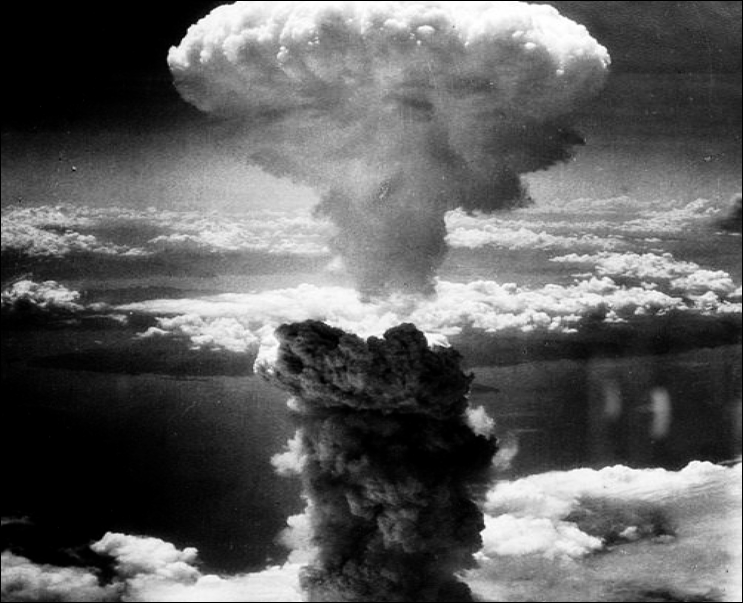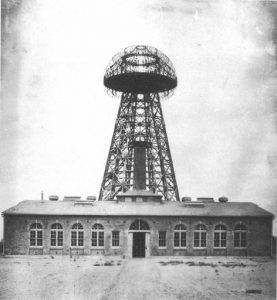Winner of the Spring 2017 StMU History Media Awards for
Best Article in the Category of “World History”
“We knew the world would not be the same. A few people laughed, a few people cried, most people were silent. I remembered the line from the Hindu scripture the Bhagavad Gita. Vishnu is trying to persuade the prince that he should do his duty and to impress him takes on his multiarmed form and says, ‘Now, I am become Death, the destroyer of worlds.’ I suppose we all thought that one way or another.”1
- J. Robert Oppenheimer, The Decision to Drop the Bomb

Throughout the history of human warfare, conflict has pushed humans to innovate–to build ever larger and deadlier weapons, each more lethal than the last. However, it was not until World War II and the invention of the atomic bomb that humanity has been able to kill on such a massive and efficient scale. Case in point, in the final days of World War II, the United States carried out one of the most chilling instances of mass murder in the history of humanity: the bombing of the Japanese cities of Hiroshima and Nagasaki. These attacks ultimately killed an estimated 294,000 people, the majority of whom were noncombatants.2 In comparison, the Japanese attack on Pearl Harbor killed just 2,408 American citizens, although this is largely due to the focused Japanese attack on military targets, namely the Pacific fleet and U.S. airfields.3 To give a more modern frame of comparison, the terrorist attacks against the World Trade Center and Pentagon, considered to be by far the worst terrorist attacks against the United States, claimed the lives of 2,974 American citizens.4
In the spring of 1945, World War II was entering its final stages. The Allies had already achieved victory in Europe with Germany’s surrender on May 7th, but the conflict on the Pacific front was still going strong. In the years leading up to the two World Wars, Japan’s victories against two larger countries–China in the Sino-Japanese War (1894–1895) and Russia in the Russo-Japanese War (1904–1905)–combined with other factors, forged a strong sense of Japanese nationalism, militarism, and cultural superiority. This fervent nationalism, integrated with the Japanese warrior ethic known as bushido, made the prospect of a Japanese surrender unlikely, even as the Allies began to position for an invasion of the Japanese mainland.5

Concurrently, since as early as 1942, President Franklin Delano Roosevelt had been secretly sponsoring and funding The Manhattan Project, the code name used for the $2 billion U.S. effort to develop a nuclear weapon before the Germans. A team of top physicists led by Dr. Julius Robert Oppenheimer were assigned to this project, a task so secret that not even individuals as important as then Vice President Harry S. Truman was aware of it. Shortly after Roosevelt’s untimely death and Truman’s subsequent inauguration to the presidency in April 1945, he was informed that the Manhattan Project was approaching success–that a nuclear weapon would be feasible in just four short months.6
Faced with the prospect of a costly and deadly invasion of Japan, Truman and his advisors were faced with a difficult choice: utilize this new atomic weapon or try to defeat Japan through conventional means. In late July, the United States issued the Postdam Declaration, a statement which gave Japan the choice between unconditional surrender or total annihilation. When this declaration went ignored, President Truman authorized the use of the atomic bomb.7

On the morning of August 6, 1945, Colonel Paul Tibbets piloted the Enola Gay over the city of Hiroshima, where his crew dropped an atomic bomb code-named “Little Boy.” Upwards of 70,000 people died instantly in the blast. Additionally, 48,000 buildings were destroyed and another 22,000 were damaged, leaving only 6,000 buildings untouched. Three days later, on August 9th, a second bomb was dropped onto Nagasaki, killing another 36,000 people. In total, an estimated 295,000 were killed in the blasts or from complications from the resulting nuclear fallout.8
Emperor Hirohito ordered the surrender of Japan on August 10, 1945. On August 15th, radios across Japan broadcasted Hirohito’s words as he read the declaration of surrender to the Japanese people, thus ending World War II. The bombs’ effectiveness in forcing the Japanese to surrender is still subject of popular debate among historians to this day, given that the Russian invasion of Japan-controlled Manchuria occurred at the same time of Nagasaki, both of which likely impacted Japan’s will to continue fighting.9 Even so, while the political and military effects of these blasts may be debated, none can contest their tragedy and devastation.

- Jason Pontin, “Oppenheimer’s Ghost,” MIT Technology Review, October 15, 2007. https://www.technologyreview.com/s/408835/oppenheimers-ghost/. ↵
- Dennis W. Cheek, “Hiroshima and Nagasaki,” in Encyclopedia of Science, Technology, and Ethics, edited by Carl Mitcham, Vol. 2, Detroit: Macmillan Reference USA, 2005. Gale Virtual Reference Library (accessed February 6, 2017), 923. ↵
- Sonia Benson, Daniel E. Brannen, Jr., and Rebecca Valentine, “Pearl Harbor Attack,” in UXL Encyclopedia of U.S. History, Vol. 6, Detroit: UXL, 2009. Gale Virtual Reference Library (accessed February 6, 2017), 1208. ↵
- Stefan M. Brooks, “September 11 Attacks,” in The Encyclopedia of Middle East Wars: The United States in the Persian Gulf, Afghanistan, and Iraq Conflicts, edited by Spencer C. Tucker, Vol. 3, Santa Barbara, CA: ABC-CLIO, 2010. Gale Virtual Reference Library (accessed February 6, 2017), 1096. ↵
- “The United States Drops the Atomic Bomb on Hiroshima and Nagasaki,” in Global Events: Milestone Events Throughout History, edited by Jennifer Stock, Vol. 2, Asia and Oceania, Farmington Hills, MI: Gale, 2014. Gale Virtual Reference Library (accessed February 5, 2017), 361. ↵
- “An Overview of the Atomic Bombings of Hiroshima and Nagasaki,” in The Atomic Bombings of Hiroshima and Nagasaki, edited by Sylvia Engdahl, Perspectives on Modern World History, Detroit: Greenhaven Press, 2011. Gale Virtual Reference Library (accessed February 6, 2017), 13-14. ↵
- “An Overview of the Atomic Bombings of Hiroshima and Nagasaki,” in The Atomic Bombings of Hiroshima and Nagasaki, edited by Sylvia Engdahl, Perspectives on Modern World History, Detroit: Greenhaven Press, 2011. Gale Virtual Reference Library (accessed February 6, 2017), 14-15. ↵
- Dennis W. Cheek, “Hiroshima and Nagasaki,” in Encyclopedia of Science, Technology, and Ethics, edited by Carl Mitcham, Vol. 2, Detroit: Macmillan Reference USA, 2005. Gale Virtual Reference Library (accessed February 6, 2017), 923. ↵
- “The United States Drops the Atomic Bomb on Hiroshima and Nagasaki,” in Global Events: Milestone Events Throughout History, edited by Jennifer Stock, Vol. 2, Asia and Oceania, Farmington Hills, MI: Gale, 2014. Gale Virtual Reference Library (accessed February 5, 2017), 361. ↵



152 comments
Samuel Stallcup
A truly remarkable and unforgettable time in history. This event shows two things: a new weapon that any country could create and use, and it roughly showed the end towards the second World War. The former has caused a lot of technology (new weapons technology) to be created, a new form of energy, and a lot of fear. Great article.
Elias Garza
Weapons are fascinating because they have no ability to do things on their own but their purpose are deadly. I feel like guns are a form of technology that are constantly getting better. Eventually, if the weapons are developed enough, the country that has them has the power as well. I believe those with power should always think twice with their actions. These actions may hurt innocent people that do not deserve it.
Elias Garza
Weapons are fascinating because they have no ability to do things on their own but their purpose are deadly. I feel like guns are a form of technology that are constantly getting better. Eventually, if the weapons are developed enough, the country that has them has the power as well. I believe those with power should always think twice with their actions.
Alexandra Cantu
I had studied this tragic event back in my history class and I was so surprised to find out that this mission or task was so secretive not even the Vice President knew. The thousands of lives taken from these bombings is really sad. We always hear America is great doing great things but this one was one we all wanted to throw under the rug and forget about. There was no way Japan could fight back after such devastation.
Nathan Hudson
Can we credit this devastation only to the American people who dropped the bomb? I don’t think that the blame of this tragedy only falls on the U.S. The Japanese emperor was not going to surrender, because of this, the war had to end through the atom bomb. I hate the fact that extreme destruction was the way used to stop the largest war in history, but who knows what the alternative would have brought us?
Rafael Lopez-Rodriguez
Reading about what happened during this war is heartbreaking because of the results the launching of these bombs had. This bomb not only changed how we view war now, it made a big impact on the world. Releasing these bombs I think was a way for the US to show the world to be afraid of them or something. I believe there could’ve been a different way to end this war but I guess the US did not care about the impact this was going to make. This was an event that changed the course of history.
Christopher Sanchez
Upon reading this article I remembered in history class that this was the most dreadful thing America has done. Not only dropping two atomic bombs to kill soldiers but as well killing innocent people going about their day. This shows that war can put fear into people that makes them do outrageous things, this event will never be forgotten.
Destiny Flores
Being an American, you hear about these monumental historical moments, but never to the extent of the damage that was done. We killed SO many more of their people than they did ours, its mind boggling to try to imagine just how many people were murdered. It makes me question if we hadn’t used it, could we still have won the war? Was it necessary?
Brandon Martinez
This article is very interesting adding more backstory to these weapons that isn’t well known. I didn’t realize that the weapons had code names and other secretive hidden terms that were only used for the bombs. I learned more about these bombs and their backstory than I had previously. The research of this article adds not well known history about the making of these weapons and how the government wanted to use them prior to the bombing of Japan.
Hector Garcia
The tragic events of the Nagasaki and Hiroshima have been one of the most iconic moments of unnecessary violence. The lost of lives from these bombings has scarred the environment of Japan with radiation that has affect tens of thousands Japanese citizens. This article is descriptive and shows that actions that took place for the bomb to be created. It also showed the destructive power that nuclear weapons have.